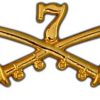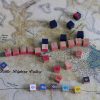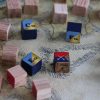Description
Little Bighorn is a Military Strategy Board Game that recreates the famous battle of Custer’s Last Stand, known to the Lakota and other Plains Tribes as the Battle of the Greasy Grass.
Everybody knows now why Custer lost. He attacked while being outnumbered over 10:1! No player would ever do that in a game.
Army intelligence only estimated the ‘hostile’ strength at 800. Unbeknownst to the army, the camp’s numbers had suddenly swelled the day before as the Plains Tribes gathered for the long-standing ceremonial tradition known as the Sun Dance.
-The most important religious even of the year. A time for prayer and personal sacrifice for the community and making personal vows.
Instead of 800, Custer was quickly overwhelmed by 2,000-3,000 warriors of the combined tribes of the Lakota Sioux, Northern Cheyenne, Arapaho and others.
In this game, you must fight this battle blind, as your historical counterparts did: against an unknown number of forces. Either side can bring any force they want. Will the Cavalry have all 4 battalions, including the pack trains and gatling guns for support? Will the Sioux side have all 7 tribes in camp or just 1?
The Victory Conditions vary depending on the forces the players bring to the battle. If the Cavalry advances too cautiously, they could easily lose if the Sioux run away with only 1 tribe.
A small Cavalry force can still win if badly outnumbered by driving hard and capturing a NC piece. (Non Combatant: elders, women and children.) This was Custer’s plan to minimize casualties. He hoped that capturing and holding the NCs hostage would force the warriors to quickly surrender.
Custer nearly pulled this off, in spite of the numbers. Instead, Sitting Bull’s (Tȟatȟáŋka Íyotake) visions inspired the battle. He personally organized a defense and escape of the NCs while bold leaders like Crazy Horse and Chief Gall launched rapid, encircling strikes. Little Bighorn became an overwhelming victory for the Lakota, Northern Cheyenne, and Arapaho.

Crazyhorse
Components List
- Pub Battles Rules
- Map, 32″ x 17″
- Scenario / Setup
- Measuring scale card.
- Hardwood blocks with custom stickers
Some Assembly Required
Learn more about the Pub Battles system.

Gamer’s Assessment
If the Cavalry drives hard and fast, they can win by capturing NCs. If they fail, it is going to get ugly real quick. Both sides get to play offense and defense. Few pieces are scattered along a very long map. There are hills to defend along but you won’t see a lot of stagnant battle lines here. Both sides are going to be constantly moving in a running battle. This battle is very fluid and epic feeling.
Upgraded Premium Map:
Real maps of the period were printed on canvas. This authentic, premium map is tough, durable and beautiful. Printed on 100 year, museum quality, archival canvas. It is water resistant, spill proof and lays flat and smooth. Truly a work of art.






































Tom –
Little Bighorn is a fast-paced and interesting game of Custer’s famous fight on the Little Bighorn. It is one of the most interesting Little Bighorn games that I have played, and I have played most of them. A deceptively simple game system recreates the difficult tactical choices confronting Custer and his command, and allows players to explore the consequences of different decisions.
A note of caution here – while this game is marketed as a “Pub Battles” game, it actually has a completely different and unique game system, designed specifically for the Custer fight. It makes for a gaming experience that is distinct from other Pub Battles games, and is fascinating in its recreation of the swirling, unpredictable fights along the Little Bighorn.
The game has one of the best maps I have seen of the Custer battlefield, accurately capturing the military significant terrain and identifying key landmarks. This is not a small thing – maps of the battlefield as it existed at the time of the fight are notoriously problematic, and this one is outstanding, as well as being a real work of cartographic art. Battle enthusiasts will enjoy acquiring the game for the map alone.
The game avoids traditional hex-based systems altogether. Movement is regulated by a simple combination of distance and terrain, using measuring sticks (take note – the measuring sticks must be ordered separately, although it is fairly easy to make your own using the movement gauges printed in the game rules). Units are small blocks of wood, representing companies (and battalion headquarters) for the cavalry and small groups of warriors for the Sioux. The Sioux are grouped into seven identical “tribes.” Each tribe also includes a critical “Noncombatants” unit, capture of any one of which will end the game (and usually result in a victory for the cavalry).
Some historical purists will object to the absence of tribal designations, and the identical nature of each tribe. Some other games have very specific Sioux orders of battle, with differing strengths, combat capabilities, and including key leaders and arcane leadership rules. In this case, I think the simpler approach is better. The truth is we have no idea who was really at the battle on the Sioux side, or what their strength, equipment, or specific capabilities were, other than in the most general terms.
The key component of the Little Bighorn system is its variation in how many tribal encampments are actually present, from a minimum of one to a maximum of seven. This critical feature accurately reflects what Custer expected to find in the valley – a series of villages, of varying size, strung out up and down the valley. The Sioux had never in living memory or oral tradition – ever – summered in a single large camp, for several very good reasons, sanitation and grazing for the huge pony herds among them. Custer expected to encounter several villages, and was probably hoping to round up two or three of them at most, declaring victory and escorting the captured tribes to the nearest reservation.
The Indian player determines prior to the game how many tribes will be present, and where. He places a single tribal marker on each of seven camps; the cavalry player will not know which markers are real until he has a unit within “spotting” distance of the camp. For their part, the Sioux cannot move until turn 4, and must exit their noncombatants off the board through two exit points on the northern (downstream) map edge. Since the cavalry enter from the south (upstream) edge of the map, the cavalry player must be able to get a force north of the village before the Sioux can get rolling after turn 4 to have any chance of victory.
Rules are simple and easy to apply, making for fast moving games that are easily completed in the advertised 1 to 1.5 hours. As with other Pub Battles games, the game is divided into a movement phase, during which each of the Army battalions and each Sioux (and Cheyenne, to be accurate) Tribe moves according to a random “chit” draw, followed by a combat phase. The Army (only) can attempt to pre-empt the Indians in the movement phase, either by forcing Indian units to move first, or by moving first with one of the cavalry battalions.
Combat results are generated by simple (and simultaneous) die rolls, using two dice per unit, with “hits” scored on a four, five or six. Complicating this process for the Indians is their treatment as “Militia,” giving the Army a significant combat advantage. The significant numerical superiority enjoyed by the Indians (even if only two or three tribes are present) can counterbalance the cavalry’s advantage in combat, but only if the Indians can engage single cavalry units with two, three or even four warriors at a time. This last point makes positioning cavalry units in mutually supporting positions – too close for Indians to engage with more than one warrior unit – a key Army tactic. It also makes open flanks potentially fatal for the Army.
Tactically, the overwhelming numerical superiority usually enjoyed by the Sioux can be deceptive. A careless Indian player who cedes the initiative to the Army can find himself severely punished over the course of two or three turns, reducing his ability to successfully screen the withdrawal of his non-combatants. The Army’s tactical advantage combines with two other factors to enable the occasional Army victory: the Army’s ability to engineer two consecutive moves, and the unique capacity of the Custer unit to attack during the Army movement phase. This gives the Army the ability to open a “hole” in the Indian line with Custer, then move through and attack with other units. This requires the Indian player to maintain a layered defense at all times, as the Army can and will punch through outer layers in the combat phase, then seize the initiative to move immediately in the following turn, again led by the Custer unit. Once a single Army unit contacts (by being fully adjacent to) any noncombatant unit, the game ends immediately (before the ensuing combat phase).
Victory conditions for the game are variable, depending on how many cavalry battalions and tribes are present. Generally, more tribes or fewer battalions makes it easier for the cavalry to win, while fewer tribes or more battalions make Sioux victory conditions easier to achieve.
The key to winning for the cavalry is early reconnaissance to determine how many tribes are present, combined with a flexible strategy to accommodate the level of Indian superiority in numbers, once it becomes apparent. Small numbers of tribes require highly aggressive Army play, while large villages will force a much more cautious approach. Even with most tribes present, the Army has a chance for victory. More tribes means more noncombatants, with will be more difficult to screen effectively against the Army’s ability to combine consecutive moves with Custer’s unique attack capabilities.
An additional – and significant – advantage for the Army is in mobility. All of the Army units except for the pack train and the “Gatling Guns” (ahistorical – Custer left the guns behind, as they limited his mobility) are mounted, while most Indian units are on foot. This advantage is fleeting, however. Once a cavalry company has engaged in combat, it moves dismounted for the remainder of the fight (the Indians have run off its horses). This feature, besides simplifying play, makes it wise for the Sioux player to engage cavalry units early, even with single warrior attacks. The cavalry will almost always win these initial engagements, but will be deprived of their mobility advantage for the remainder of the game.
The mix of Tribes and the varying configuration of the villages makes each game different. The action can shift rapidly from daring cavalry attacks to seize noncombatants and end the game, to desperate fights for survival by encircled Army battalions on isolated hill tops. It is a fun game to play, easy to learn but difficult to master.
Robert Caplinger –
Excellent game on Custers last stand.
Map, pieces great, rules simple, tactics and strategy needed by you yourself.
Game is excellent against an opponent.